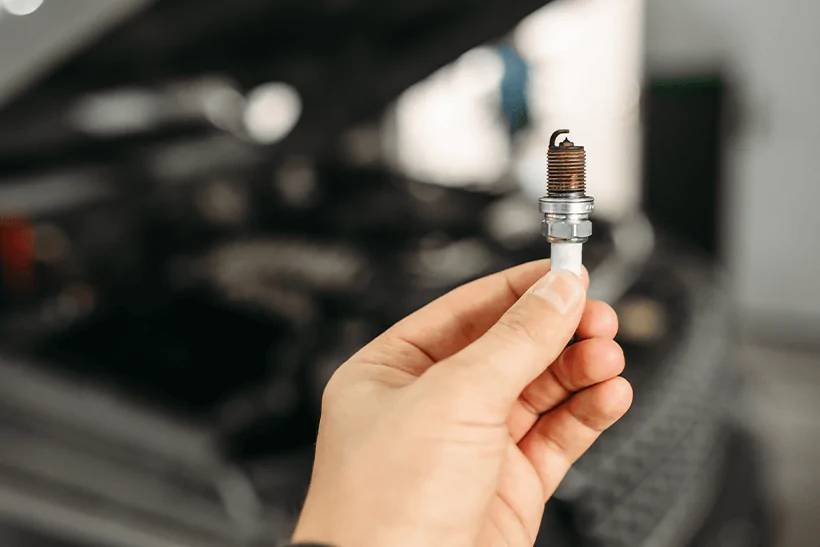
Spark plugs are a critical part of your internal combustion engine, so mechanics can charge a pretty penny for removing and refitting these. But, the good news is that you don't have to shell out on pricey repairs if yours become worn or break: changing spark plugs is a fairly straightforward task that most people with some mechanical knowledge can do at home.
To prolong your spark plugs lifespan as much as you can, it's vital that you know how to clean them thoroughly and how often you'll need to test them. Similarly, you'll need to be clued up on signs of spark plug failure to know when to change the spark plugs in your car. If you need a new set of spark plugs, just click here, and we’ll show you what’s available.
If you've never done this yourself before, don't worry! Our handy spark plug guide will ensure you at least know the basics of changing, cleaning and testing your spark plugs. We'll cover:
What Are Spark Plugs and What Do They Do?
Faulty Spark Plugs and How to Spot Them
How Do You Quickly Test a Spark Plug
How to Remove Old Spark Plugs
How to Clean Used Spark Plugs
How to Fit New Spark Plugs
Spark Plug Know-How
What Are Spark Plugs and What Do They Do?
While spark plugs may appear simple in design, these parts are integral to a handful of varied and critical jobs within your car's motor and are vital to its overall efficiency.
But what exactly does a spark plug do? They are responsible for delivering an electric current from your ignition to the combustion chamber. This, in turn, ignites the mixture of compressed fuel and air via the electric spark while also containing combustion pressure inside your engine. In simpler terms, they generate tiny bolts of lightning, which deliver electricity to your engine, helping it to run.
There should be a spark plug for each cylinder, although in certain engines – including the Alfa T-Spark – there are two per cylinder. The spark plugs resemble metal shells and can be found screwed into your engine's cylinder head. They are electrically grounded, protecting you from electric shocks and providing a return path for the electrical current.
In newer car models with engine compartments with many emissions tubing and computerised sensors, getting a professional's help may be better to ensure you don't damage any engine parts while trying to access your spark plugs.
Faulty Spark Plugs and How to Spot Them
Inspecting their condition and function before you spend time removing, cleaning, and refitting your spark plugs is essential. There are a couple of signs that suggest you may have a broken or failing spark plug, which will need to be replaced. This could include:
Slow Acceleration
Poor acceleration is commonly associated with a problem within the ignition system, most likely a worn-out spark plug. Spark plugs are made from materials that work together to produce a spark at a high enough temperature to ignite the air-fuel mixture. When these materials wear out, the effectiveness of the spark plug is reduced, meaning your car's acceleration can significantly slow down.
So, pay attention to the movement of your car, particularly if it feels like it's struggling or doesn't accelerate as fast as it used to. These can be symptoms of various other problems with your vehicle, including a faulty or blocked fuel filter or oxygen filter issues. We recommend consulting a mechanic before you begin any work on your spark plug.
Poor Fuel Economy
A spark plug that works correctly will burn fuel efficiently through the combustion cycle, helping your car achieve better fuel economy. However, when the plug isn't functioning correctly, it's often because the gap between the spark plug electrodes is too close or far apart. This is when you will need to adjust the gap and return them to the distance that your manufacturer's manual recommends. Similarly, if your car struggles to use the fuel economically, your spark plugs might be worn out and need completely replacing.
Misfiring Engines
A misfiring engine usually has to do with an issue in the ignition system or a fault with the computer sensors in newer models. But, it can also be caused when a spark plug wire or tip of it that connects to the wire is damaged.
A misfiring engine can be associated with intermittent spluttering sounds. It will cause your engine light to illuminate on the dashboard. And, if you leave it misfiring, polluting exhaust emissions will increase, while acceleration and fuel economy will significantly drop.
A misfiring engine can be a severe problem, so you must try to avoid trying to fix this yourself. Instead, you'll need a professional to take a look and advise you.
Problems Starting the Engine
Having trouble starting your vehicle can indicate that your spark plugs are worn out and need replacing. But, as with any of the above, a professional should initially look at a non-starting engine before you begin replacing the spark plugs. You can also check our ‘Troubleshooting Starting Guide’ if you need to further explore starting issues.
Rough Idling
Rough idling is characterised by a rough and bouncy feeling when a vehicle's engine is running. This is usually caused by a problem in a car's ignition system and can be commonly attributed to faulty spark plugs and their wires. As well as the vehicle feeling shaking, you might also experience odd RPM counts – the RPM of a car is usually a smooth, consistent 1,000. But, anything higher or that fluctuates is a problem.
How Do You Quickly Test a Spark Plug
Knowing how to test a spark plug is crucial for ensuring it is in good working order, contributing to better fuel efficiency, engine health and safety. While no set amount of time needs to elapse before you check these, it's best to take the guidance from your manufacturer's manual.
Although it won't give you exact times to test your spark plugs, it'll provide a guideline for how often to change your spark plugs and, therefore, when they'll need replacing. But be aware that different spark plugs will last for various timeframes. For example, this could be between 30,000–60,000 miles, so a good time to test your spark plugs would be at the halfway mark.
To do this, you will need to earth your spark plugs. To do this:
Remove the spark plug
and reconnect the spark plug wires (also known as high tension or HT leads), holding the boot of the wires with a pair of insulated pliers.
Hold the spark plug in a position that
almost touches the engine block
.
Remove the fuel pump fuse
. This will stop fuel from being injected into the cylinder and out through the spark plug, which could potentially be very dangerous. It will also prevent the car from firing up the other cylinders.
Get somebody to attempt to
start the engine
.
If your spark plugs are in good working order, you'll observe a strong blue spark go from the plug to the engine, whereas there will be a yellow spark or none at all if they aren't working correctly. However, if you have trouble checking this yourself, you can get a spark plug tester, which is simple to operate.
All you'll need to do is remove the spark plug wire and plug the tester in to connect to the end of the HT lead and the base of the spark plug. Once you've set this up, turn on the engine, which will light up if it receives good electrical energy.
However, if you decide to test your spark plugs and they are omitting a weak spark, it may be time to remove them and give them a good clean. We will be explaining how to do this in the following few sections.
How to Remove Old Spark Plugs
When you reach for each of your spark plugs, you'll undoubtedly be greeted with a build-up of soot, noticing that the spark plug is black, which is entirely expected, considering they create thousands of explosions inside your engine each day. But before you can begin cleaning these, you'll need to know how to remove your spark plugs safely and correctly.
To do this, you'll need to follow these steps, disconnecting one spark plug at a time:
Locate the wire connected
to the spark plug or ignition wire, then locate the spark plug. Be aware that these could be hidden under several parts, including the ignition coil, so look carefully.
Using a ratchet, place it around your spark plug socket and pull on the spark plug
boot (the connector at the end of the wire). Be careful not to pull on the wire itself, as this could damage both the wire and the connector.
Remove the spark plugs from the sockets using a torque wrench by turning it in an anticlockwise direction. If this is proving challenging, don't force it; you may break the spark plug off. Instead, try a penetrating oil that will help loosen these.
Inspect the old spark plug: it should only be a little dirty. If you spot any oiliness or white substances on it, it could mean there are other issues at hand which will need to be investigated by a professional. If not, you can begin cleaning your spark plugs (see next section).
Repeat for the other spark plugs.
How to Clean Used Spark Plugs
Your spark plugs require maintenance like any other car part, and cleaning is integral to prolonging their lifespan. Most notably, you'll need to pay attention to the gap between these and the ignition and combustion chamber, which can increase the length of time that your spark plugs last.
More specifically, under moderate driving conditions, the gap in your engine will increase about 0.001 inches with each 2500 miles you travel. However, adjusting your spark plugs back to their correct position (as specified by the manufacturers) and cleaning between the gaps can increase their lifespan by several thousand miles.
Cleaning your spark plugs is relatively simple; all you'll need is a piece of sandpaper, an air hose and a little bit of elbow grease. For the best way to clean your spark plugs, follow these steps:
Fold the sandpaper in half and slide it back and forth through the gap between the spark plug arm and electrode. If the gap isn't large enough for folded sandpaper, use it flat, but remember to sand each side.
Slide the sandpaper between the white insulator and the electrode to remove any built-up debris that may be hiding in the groove.
Blow loose sanding debris away with an air hose.
The above method can be used for cleaning almost all types of spark plugs. However, if you have platinum- or iridium-tipped spark plugs, your cleaning routine may need to be adapted slightly. These spark plugs have either platinum or iridium welded onto the centre electrode and ground electrode and will need to be replaced every 100,000km–240,000km travelled, depending on the manufacturer's instructions. But, they won't need the plug gap adjustment and, in most cases, won't need cleaning between replacements if the engine runs smoothly.
However, if you have to clean platinum-tipped or iridium-tipped electrodes, they should be cleaned for a few seconds – around 2 seconds – in a spark plug cleaner. Do not clean them like other spark plugs, which could damage the electrodes.
How to Fit New Spark Plugs
Once they're clean, you'll need to know how to fit your spark plugs again. You should fit one spark plug correctly before doing the other.
Check that the gap on the spark plugs is correct before installation. You can do this using a gapping tool and the guidance given in your manual. Once you've set these, be sure to double check they're right.
Place the spark plug in the socket and turn it clockwise a couple of times by hand.
Use a torque wrench and the spark plug socket to tighten it clockwise.
Replace the spark plug wire boot or ignition coil and wire connector. If you have a plastic boot, listen out for a clicking sound, which means it's correctly secured.
Repeat for the other spark plug.
If you'd like to watch the procedure being done before you give it a go, or you want something to follow as you are changing your spark plugs, this DIY tutorial by ChrisFix shows you just how it's done:
Spark Plug Know-How
Spark plugs are essential to your car's transmission and ignition systems, so repairs can be costly when you go to a garage. Hopefully, this guide has given you a good understanding of how to detect bad spark plugs, clean and change them.
Here at GSF Car Parts, we stock a selection of replacement spark plugs and other key ignition system parts to help you keep your car running smoother for longer.
Shop Spark Plugs at GSF Car Parts Online and In-Store
All our spark plugs are from trusted brands in the motoring industry, so you can count on them to be reliable and of excellent quality. Plus, our low-price promise means you can always expect great value, too.
We offer free UK delivery on all online orders over £25, plus 60-day returns*. We also know you want to get your car up and running as soon as possible, which is why we offer a Click and Collect service that allows you to get your new spark plugs in just an hour.
So, buy spark plugs from us with confidence today. Or if you're close to one of our 190 stores locations across the UK & Ireland, drop by. Our experienced staff will be able to direct you to the correct part for your vehicle.





